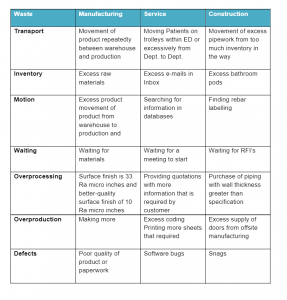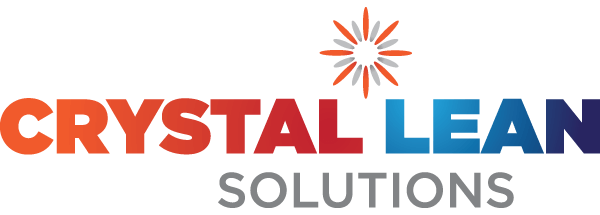8 Wastes
The focus of Lean is to deliver customer requirements and to allow activities to flow to deliver these requirements. Any actions that are not of benefit to your customer are considered non-value added or waste activities. There are 8 wastes, and these can be found in any organisation including manufacturing sites, construction projects, software companies and service industries.
Within Manufacturing, examples of waste include rework, errors in paperwork, poor layout, excess movement of people or product.
For Service organisations, waste examples include copying for example 10 people on an e-mail, when 8 are not required, using manual inputs into excel and duplicating the same information into an ERP system.
Examples of waste within Project Management include waiting for RFI’s, waiting for materials, incorrect design details or excess delays in design approval. Recognising and removing waste is essential for successful project management. In order to improve productivity, the focus is to identify and remove waste activities from the business processes, without people required to work harder.

Examples of 8 Wastes
Originally, there were seven wastes identified by Taiichi Ohno at the Toyota Production System. As Lean evolved into the rest of the enterprise and around the world, an eighth waste was identified. The acronym TIMWOODS is used to help remember the 8 wastes.
The 8 wastes are:
- Transportation
- Inventory
- Motion
- Waiting
- Overproduction
- Over processing
- Defects
- Skills: Non-utilised Talent
Direct observation is a useful process to identify and structure wastes by type, so that the appropriate Lean tools can be selected to eliminate these wastes and increase process output. By continuously repeating this direct observation process, continuous improvement becomes part of the DNA of the business.
How the Eight wastes impact efficiency:
Transportation
Unnecessary transportation losses include the time, money, and resources associated with unnecessary transportation of materials throughout the facility. For each product, ideally outline flow to optimise efficiency which will reduce travel to get from one stage of the manufacturing process to the next. You may have to consider revising the layout of your facility to improve the organisation of production. This will improve the workflow of the facility and minimise the associated losses.
Inventory
Excess inventory means ordering too many materials that are not aligned to customer requirements. Large inventories absorb significant costs, including purchasing and storage cost, without cash flow from the customer as its not required. To manage inventory, Kanban’s system is a useful method of order management to controlled stock levels. This also links with forecasting, planning techniques and purchasing, to stay on top of trends and avoid miscommunication with suppliers and customers.
Motion
Excess motion is unnecessary movement of people including unnecessary walking, finding materials, searching for information or the right inventory. Excess motion can also be a result of excess inventory, which can also cause both excess motion and transport. To reduce movement, consider the flow of people within the process and design the layout to minimise movement. 6S methodology can be a useful Lean process to implement to reduce excess motion.
Waiting
Excess waiting involves waiting for product, information, people or raw material. Machine downtime can also drive excess waiting times which then have a negative impact on efficiency and productivity. To avoid this waste, consider flow of information and how information can ideally be available real time. Preventative maintenance programme can also reduce waiting time for unplanned equipment downtime. Clear communication channels such as Daily Accountability process can be established between teams, which can support seamless movement of product or information flow.
Overproduction
Companies often produce more products than customers require, which absorbs cost yet may not result in sales. Overproduction in manufacturing can sometimes be scheduled to compensate for poor quality. One area of focus can be to improve quality to reduce overproduction driver. In construction, off site manufacturing can over produce doors for example. This can then result in excess inventory onsite, which then absorbs movement waste as doors may be in the way.
Over Processing
Over processing activities mean extra work or steps in the process that are not needed for the customer. Examples could include over polishing to a surface finish not required. Or purchasing 316L ss when 304 is sufficient. Reasons for over processing can include incorrect data collection, lack of communication, incorrect design specification, duplication of authority or human error. One useful way to combat overprocessing waste is the ensure that design and or specifications are fully aligned to customer requirements, and these are then followed through to procedures and work instructions. Adequate level of sign off can also be helpful.
Defects
Losses due to defective products are products or services that do not meet company or customer standards. This can include scrap or reworking product, snags in construction, bugs in software or incorrect data entry for service organisations. Quality control is a good containment of defective waste. Proactive strategies can include human error prevention, error proofing to prevent a defect from occurring or alerts that identify when a defect has occurred. Defects can also be a result of excess inventory, that as to be moved, which can then get damaged when moved. Preventative maintenance programmes will also support defect reduction. Statistical Process Control is also useful to predict special cause trends and Measurement System Evaluation ensures that the measurement system is capable.
Skills: Non-Utilised Talent
While untapped talent is not a waste, it is a waste of human potential that can seriously affect productivity. This can occur due to inadequate training of employees on new equipment or new technologies, as well as inadequate use of employees’ potential for feedback or development of new ideas. To deal with these losses, employers can schedule regular training for all employees to learn new equipment or refresh previous knowledge. Employers should also keep communication channels open for employees to provide feedback and suggestions for improvement.
Lean Processes to manage reduction of the 8 Wastes:
- Gemba Walks focused on waste reduction
- Ideas process
- Visual Boards
- Direct Observations as input to Standards
- Include as part of a scorecard and review weekly
- Process Mapping – Current and Future State
- Kaizen Blitz
- Integrate into Daily morning reviews
- Recognition programmes
In Summary

Lean is focused on delivering value and any activity that is not generating value, is called a non-value added or waste activity. There are 8 sources of waste (TIMWOODS) and with Lean deployment, the organisation systematically identifies and eliminates waste to improve productivity, within any additional personal effort.
Some changes can be more difficult to make, especially if the process has been done the same way for many years with no obvious issue. For any significant changes, consider cultural change management process to manage change effectively. Lean tools that can support elimination of waste include process mapping, gemba walks, direct observation, 6S, upstream/downstream process collaboration, kaizen and training.
Being able to identify waste in the first instance is important. The biggest risk to a business is assuming that how work is done today is the only way. Looking at your current state with a critical view will help you create a structured approach for continuous improvement into the future.
How CLS can help you
Our team has the experience and expertise to support clients in the identification and reduction of waste across multi sector businesses as well as the skills to support and coordinate effective process management to eliminate wasteful practices and drive continuous improvement.
CLS provides Lean Modules to deliver the knowledge and skills to conduct a short, focused productivity improvement project, using 8 Wastes tools. We adapt our programs, availability and location to meet unique capability requirements. After completing this module you’ll be able to translate learning into business results eliminating all of the unnecessary losses.
